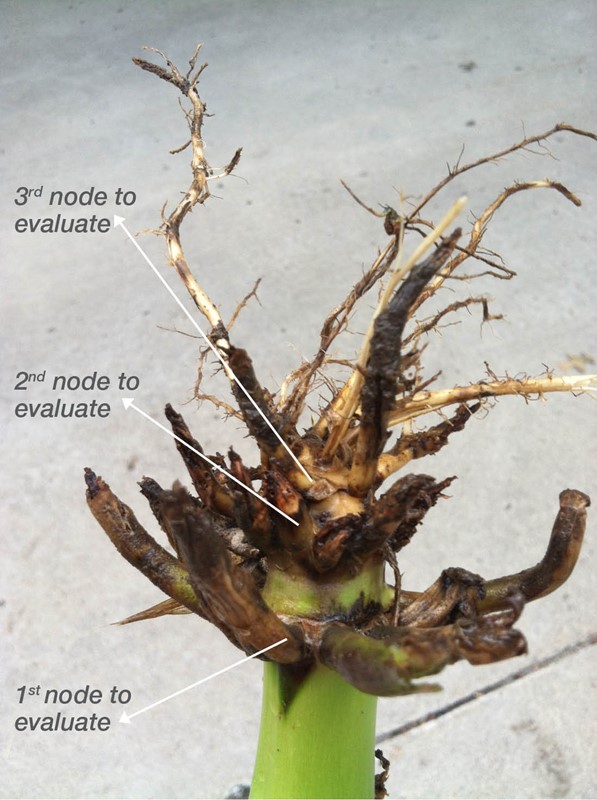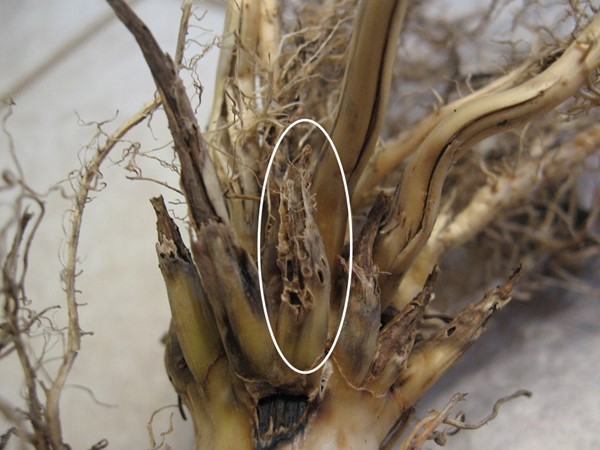Root digs: How to assess corn rootworm damage
May 10, 2021
So
you laid out your sticky traps last season and it turns out you have a corn
rootworm (CRW) problem this season. Now what?
The
first thing is to start this season right by employing all the CRW mitigation
methods you can. Read
this article to find out more.
Even
if you’ve done everything suggested there, keep a close eye on the crop around
the tasselling stage (VT). This is about the same time as most CRW larvae have
completed their third larval stage and have caused about as much damage as
they’re going to do.
You
may see outward symptoms like goose-necked stalks and lots of lodged plants,
but if sticky traps last year indicated an economic threshold had been reached,
you should dig anyway to find out what’s going on.
Root
digs are the best way to evaluate actual insect pressure, assess the damage and
find out if the mitigation measures you took have been effective or need
changing up. You can accurately rate the damage using the
Iowa
State Nodal Injury Scale as a guide.
Here
are some tips for a successful corn rootworm dig.
Timing
You
want to dig right around the time CRW larvae have completed their third larval
stage. This is usually in July or August, right about when corn is tasseling,
but keep an eye on the crop because tasseling can happen much earlier if spring
and summer temperatures have been higher than usual.
The
timing of a CRW root dig is key – dig too early and you could underestimate the
level of damage; dig too late and the roots are difficult to wash and rate,
mainly due to regrowth.
Technique
As
with most crop assessment tasks, how you do it is as important as when you do
it. Here are some good guidelines to a successful CRW root digs:
- Dig up the root masses of several plants randomly selected through the field. Try not to clip the roots with your spade as you do so.
- Soak the roots in a bucket of water to remove dirt, or rinse with a hose. Roots need to be quite clean be properly rated. And be gentle – you don’t want to cause additional root injury that could a make assessment more difficult.
- CRW damage will appear as scarring, tunneling and clipped or pruned roots. In severe cases, entire root nodes may be missing.
How to rate roots
You want to look at the top three nodes only – there is no need to
include brace roots in CRW damage assessments. Signs of CRW feeding look like little
brown lesions (Figure 1) but, as mentioned, root tips can be missing (Figure 2),
there can be tunneling and whole nodes can be entirely eaten away.
To make your examination, gently pull the roots back from the three
uppermost nodes and look for signs of CRW damage then assign damage ratings
using the Nodule Injury Scale (NIS) developed by Iowa State (see table below).
| NIS Rating |
Root Injury Description |
| 0.00 |
No visible root injury |
| 0.05 |
Root scarring |
| 0.08 |
Severe root scarring or roottips pruned beyond 4 centimetres (1.5 inches) of crown
10% of anooe pruned (often 1 root) within 4 centimetres (1.5 inches) of crown
|
| 0.10 |
Severe root scarring or roottips pruned beyond 4 centimetres (1.5 inches) of crown
10% of anooe pruned (often 1 root) within 4 centimetres (1.5 inches) of crown
|
| 0.25 |
25% of anooe pruned within 4 centimetres (1.5 inches) of crown |
| 0.75 |
75% of anooe pruned within 4 centimetres (1.5 inches) of crown |
| 1.0 |
A full node pruned within 4 centimetres (1.5 inches) of crown |
| 1.5 |
One full node and 50% of another node pruned within 4 centimetres (1.5 inches) of crown
Two full nodes pruned within 4 centimetres (1.5 inches) of crown
|
| 2.0 |
Three full nodes pruned within 4 centimetres (1.5 inches) of crown (maximum value) |
| 3.0 |
One full node and 50% of another node pruned within 4 centimetres (1.5 inches) of crown
Two full nodes pruned within 4 centimetres (1.5 inches) of crown
|
Root rating can be tough, so here are some visual examples to compare against.
Figure 1: Root scarring. If something like this was all you found on the root mass, it would earn an NIS rating of 0.05, meaning a little scarring but nothing to worry about if growing conditions are good.
 Figure
1: Damage on root mass.
Figure
1: Damage on root mass.
Figure 2: Root tip damage. Here you can see a shortened root indicating CRW feeding has
occurred. But at four centimeters (1.5 inches) the root is still long enough to
function. If this was the extent of damage to the root mass, this would get an
0.08 NIS rating. However, if the root had been clipped to within four
centimeters of the crown, that rating would change to 0.1.
 Figure 2: Root tips eaten by CRW.
Figure 2: Root tips eaten by CRW.
Figure 3: Severe CRW
damage. Here you can clearly see the three nodes
used to evaluate root damage. Looking at the first node, roughly half of the
roots have been pruned to within four centimetres of the crown. On the second
node fully 100 percent of the roots have been pruned that far, and on the third
node, 75 percent of the roots are pruned. This root ball has an NIS rating of
2.25.
 Figure 3: Three nodes used for evaluation of CRW damage.
Figure 3: Three nodes used for evaluation of CRW damage.
Figure 4: Close-up of
heavy feeding. You can see how this looks different
from other forms of injury, such as mechanical or fertilizer burn.

Figure 4: Heavy root feeding by CRW.
What the ratings mean
Economic
loss is likely when an NIS rating reaches 1.0 or higher. But much, as always in
farming, depends on weather. An NIS rating of just 0.25 can be enough to cause
economic loss if the crop has to contend with tough conditions, particularly
drought.
Assess
and rate all the plants you dug up and base future CRW management decisions on
the average rating across the board.
For
more information, for help in working with the NIS rating system or a second
opinion of your root dig assessments, talk to your local agronomist or seed
partner representative.